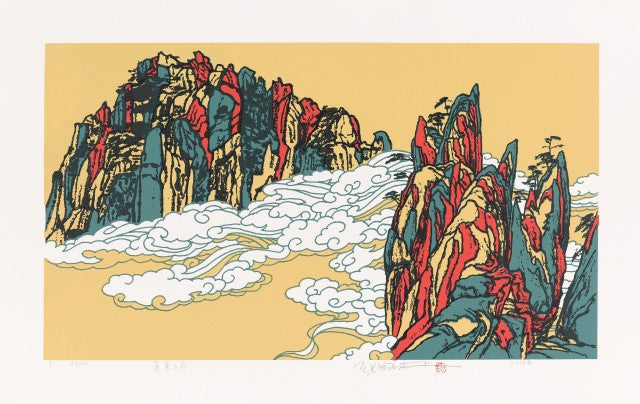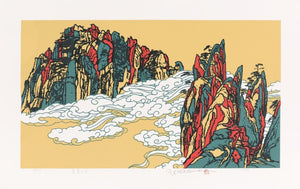Penglai Three Islands
Guolin Zhang
Artwork Details
Artwork Description
Title: Penglai Three Islands
Artist: Guolin Zhang
Date: Undated
Medium: Print
Dimensions: 34 × 60 cm (13.4 × 23.6 in)
1. Artwork Identification
Penglai Three Islands by Guolin Zhang is a 34 × 60 cm print featuring a stylized mountainous landscape enveloped in clouds or mist. The composition employs a striking color palette of red, blue-green, and yellow, creating a bold yet harmonious visual impact. This distinctive chromatic choice departs from purely monochromatic traditions, highlighting the artist’s contemporary interpretation of classical themes.
2. Artistic Style and Influences
The work reflects a fusion of traditional Shan Shui (mountain-water) aesthetics and modern printmaking techniques. While drawing inspiration from the legendary Penglai islands—a mythical realm in Chinese folklore associated with immortality—the print integrates simplified forms, strong lines, and vivid colors characteristic of contemporary design. This synthesis evokes both the spiritual essence of historical landscapes and the vibrancy of modern visual culture.
3. Historical Context
Penglai holds a significant place in Chinese mythology, often regarded as a utopian land of eternal harmony. By invoking this symbol, Guolin Zhang aligns with a long lineage of artists who have depicted legendary landscapes as metaphors for transcendence and philosophical ideals. The reinterpretation through bold colors and graphic clarity situates the piece firmly within the 21st-century revival of cultural heritage in a globalized art context.
4. Provenance and Authenticity
Please contact the gallery directly for provenance details and authenticity certification.
5. Condition and Conservation
The print appears to be in excellent condition, with no evidence of discoloration, creasing, or surface abrasion. To ensure long-term preservation, framing with UV-protective glass and archival-quality backing is recommended.
6. Artistic Significance
Penglai Three Islands exemplifies Guolin Zhang’s modernized approach to classical subject matter, merging mythical references with contemporary visual language. This ability to transform enduring cultural symbols into fresh, dynamic compositions underscores the artist’s significance in bridging traditional Chinese aesthetics with present-day artistic discourse.


